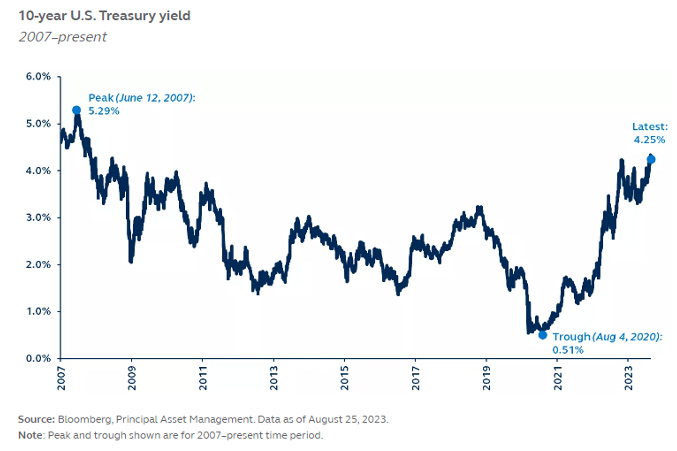
US financial markets are watched closely given the US dollar is still considered the world’s safe haven currency. Recently, Fitch downgraded the sovereign’s credit rating which barely saw markets move. There’s a lot of uncertainty regarding inflation and the direction of interest rates. This article shares two divergent views on US Treasuries.
First, the case for investing in US Treasuries from Seema Shah, Chief Global Strategist at Principal Asset Management.
Bond yields have surged to their highest level in over 15 years, propelled by resilient economic data and revised expectations for Federal Reserve policy. Nevertheless, the looming threat of subdued growth in 2024 suggests that bond yields are likely near their peak. This presents a potential opportunity for investors—add to duration exposure as the economic slowdown approaches.
The relentless bond sell-off has reached a new milestone. 10-year U.S. Treasury yields hit 4.34%, the highest level since 2007, up almost 110 basis points since the regional bank crisis earlier this year. Several factors have contributed to the sell-off:
- Robust economic growth: Incoming economic activity data has generally been very resilient, leading to an upward revision in growth forecasts.
- Higher for longer expectations: Markets have been revising their Fed rate path expectations, pushing out the date of the Fed’s projected first cut and reducing the number of cuts.
- Bank of Japan policy adjustment: The central bank has loosened yield curve control, allowing long-suppressed Japanese government bond yields to rise, raising concerns about weakening foreign demand for U.S. Treasurys.
- Greater issuance: The U.S. Treasury recently increased its estimates for government borrowing, implying greater longer-dated debt issuance.
The sustainability of the recent rise in bond yields hinges on the performance of the U.S. economy in upcoming quarters. Slowing growth next year (even a soft landing) would push inflation lower, opening the door for a less restrictive Fed policy stance, and putting downward pressure on bond yields.
While bond yields may have shifted to a higher range, they’re likely nearing their peak. Given the elevated level of yields and the potential risk of muted growth next year, this could be an opportune time to add to duration exposure.
Second, a word of warning that rates might need to go even higher from Charles-Henry Monchau, CIO at Syz Group.
A tricky time for US government bonds. US Treasuries are facing multiple headwinds – economic strength (Atlanta Fed’s real-time GDP growth forecast is tracking close to 4% for the third quarter), an uptick in energy prices and Fed QT. But another headwind is fading demand stemming from historical buyers of US Treasuries:
- China US Treasury holdings just hit a 14-year low at less than $850bn.
- Saudi Arabia’s stockpile of US Treasuries fell to the lowest level in more than six years (less than $100bn).
- As Japanese long-term yields rose (due to a tweak in their monetary policy), the largest foreign holders of US Treasuries, Japanese investors, became less interested in US bonds and asked for a premium.
This diminishing demand is very bad news for Uncle Sam. Indeed, US interest expenses have surged by about 50% in the past year, to nearly $1 trillion on an annualized basis.
Last but not least, this diminishing demand is coming at the time of heavy US Treasury SUPPLY AHEAD. As budget deficit explodes, US Treasury will sell $1 trillion in debt this quarter, 2nd highest in history – only the Covid-related $2.753 trillion in Q2 2020 surpasses it – and another US$852bn to come in 4Q23).
Bidenomics, through laws like the Infrastructure Act, the Chips and Science Act and the IRA, envisions an added $2 trillion of federal spending over the next decade. While this might stimulate the economy in the short term, it also threatens to inflate debt further, leaving taxpayers with the bill under subsequent US administrations.
Total US debt levels are expected to rise from 98% of GDP in 2023 to 118% of GDP in 2033. By 2053, Debt-to-GDP in the US is expected to hit an alarming 195% (CBO).
The Fitch downgrade, while not immediately catastrophic, is a warning about Bidenomics’ potential repercussions. This might explain Secretary Yellen’s disagreement with this downgrade, given her department’s pivotal role in shaping Bidenomics.
While yields are looking more and more attractive on the belly and long end of the US yield curve, investors are well aware of all these shortcomings and might require higher premium going forward.
































